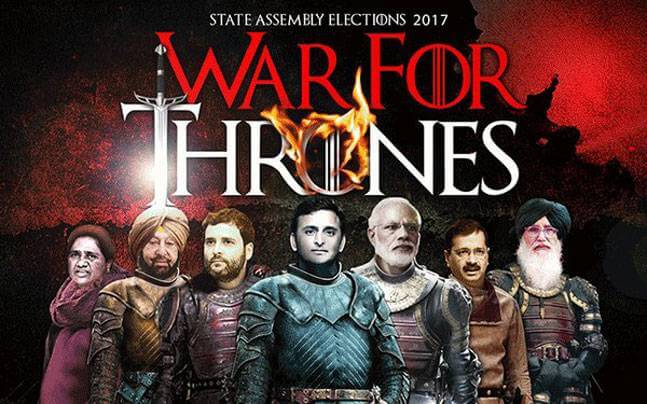By Sushant Sareen
“One big takeaway of this election is that don’t take seriously anything that the English language media tells you. Most of the analysis in the media is based on a dumbed-down, lazy and increasingly antiquated and inaccurate template or formula that revolves around caste configuration and communal composition which is then extrapolated to present an ostensibly clever analysis of how the election cookie will crumble.”
Elections At the outset, a confession: my prediction of the recently concluded five-state assembly polls went horribly wrong. I saw SP-Congress winning UP, a close fight in Uttarakhand, BJP emerging single-largest party in Goa. The only one I got right was Punjab. Manipur, I didn’t venture to guess out of ignorance. As it turns out, I was pretty ignorant about the other states as well. But I have an excuse: as an arm-chair, amateur political pundit, my predictions were based on what I read in the English press. So, if the input I was receiving was totally off the mark, the prediction was bound to be off-the-mark
In the case of Punjab, the difference was that one of my main sources of information was a lawyer relative who also happens to be one of the most savvy and clued-in political workers I have ever met. He is someone who saw the real ‘writing on the wall’ much better than some very seasoned, but also a parachute, journalists.
But while I have my excuse, what is the excuse of experienced political journalists, who claimed to be travelling ‘extensively’ through these five battleground states and still getting it so horribly wrong? Was their reportage advocacy disguised as analysis? Or was it simple lack of political sense or simply the refusal to see reality because it didn’t suit their ideology? How else do you not see a Tsunami (or as more appropriately called, TsuNaMo)? How is it that you tweet that the entire Jat belt in Western UP is a gone case for the BJP which ends up winning almost 80% of the seats? What sort of ‘writing’ did you see on the wall that led you to think that AAP was sweeping Punjab? Was this a Facebook wall (presumably of AAP supporters whose visibility and volubility is far greater than their actual political strength on the ground) or some real wall in Punjab?
The pre-election punditry – I believe nowadays it is often referred to variously as post-truth, fake news, even paid news – was quick to give way to post-poll sophistry in TV studios, where the very people who were predicting a different result in the run-up to the election were eloquently and with great erudition explaining why the result was what it was. On the day of the exit polls, one channel paraded its senior editor who tried to present an alternate scenario which went completely against the poll projection of the channel’s own exit poll. This was probably buying the insurance and keeping a fall-back position in case the exit polls turned out a dud. Again, while exit polls can go wrong because of wrong data collected, wrong assumptions and wrong calculations, where is the horse-sense of hard-nosed political journalists who could use their gut instinct to call the election right? Until the dawn of this century, veteran journalists (even in the English language press) had an ear to the ground and political instinct. And if they got it wrong, they had the humility to admit their mistake. No more.
One big takeaway, therefore, of this election is that don’t take seriously anything that the English language media tells you. Most of the analysis in the media is based on a dumbed-down, lazy and increasingly antiquated and inaccurate template or formula that revolves around caste configuration and communal composition which is then extrapolated to present an ostensibly clever analysis of how the election cookie will crumble. Academics like the brilliant Prof. Dipankar Gupta (surprisingly from JNU) have for long been insisting that caste and community breakdown doesn’t adequately explain voting patterns but to no avail. Perhaps if the so-called political pundits had taken the trouble to read, and more importantly understand, the Arrow Impossibility Theorem – Nobel Laureate Kenneth Arrow was an economist but has made a valuable contribution to science of elections – they would know that elections are seldom, if ever, decided on the basis of a single factor, even less so in wildly diverse and socially stratified countries like India.
Thus, while caste and communal considerations would certainly weigh upon voters, there would be a whole lot of other factors that would also be in play. Increasingly in India, apart from everything else, there is now the X-factor, and often enough the X+1, and sometime X+1…N factors that determine how voters vote. In India, working out these factors is certainly not easy because things change from constituency to constituency, from state to state, and from election to election. What works in one constituency or state, doesn’t in another; the mistakes in one election become the masterstroke in another and vice versa. For instance, announcing a Chief Ministerial candidate works in one state, doesn’t work in another; works for one party doesn’t for another. All this is, however, the headache of psephologists, not journalists, who are supposed to be able to read the tea leaves and point to the broad trend. And, when there is a massive wave or a Tsunami, how can any reporter on the ground not see it coming?
The only explanation is that election and political analysis is done not on the basis of facts on the ground but on the basis of political preference and ideological prejudice. A corollary to this explanation is that the logic of the elite and their perception is completely divorced from the logic and perception of the masses. The superciliousness of the elite cannot countenance how the masses are not thinking the way they think or look at things the way they look at them. No wonder then that the Manipuri activist, Irom Sharmila, who has been the toast of the left-liberal elite and had been not only feted but also projected by them as some sort of a game-changer in Manipur politics, ended up with only 90 votes. Clearly, if the constituency to which analysts, journalists and even politicians are appealing to and cultivating is a fringe, an island or a bubble-like JNU, then they will alienate the real voters, and end up paying the price for it.
This means that if the Congress and AAP think that by pandering to those who scream ‘Bharat kibarbadi’ and want ‘Bharat ketukde’ they will endear themselves to the vast multitude of people who believe in India, then the result will be what it was on March 11. Of course, this was probably not the only reason why the vote went the way it did, but each of these things weighs in the mind of voters before they vote. For instance in Punjab, the AAP’s flirtation with radical and Khalistani element did put off a lot of voters. Similarly, constantly belaboring on the issue of one remark – ‘Shamshan and Kabristan’ – and trying to make it the central point of the election, or constantly harping on the absence of a single Muslim candidate, to the complete exclusion of everything else, is the sort of dumbing down that makes for bad politics and even worse political analysis.
The bottom line is that politics has become so complex that depending on simple-minded journalists, most of them with their own political agendas, preferences and biases, is a bit of a mug’s game. So in the next election, take anything that you read in newspapers or see and hear on TV, with a pinch of salt. The actual mood of the electorate will only be known on result day. Though being a political junkie, I will probably again make my prediction when the next poll comes, and probably end up wrong again. Only next time, I will put a health warning after my prediction.
(The author is Senior Fellow, Vivekananda International Foundation. Views expressed are personal.)








